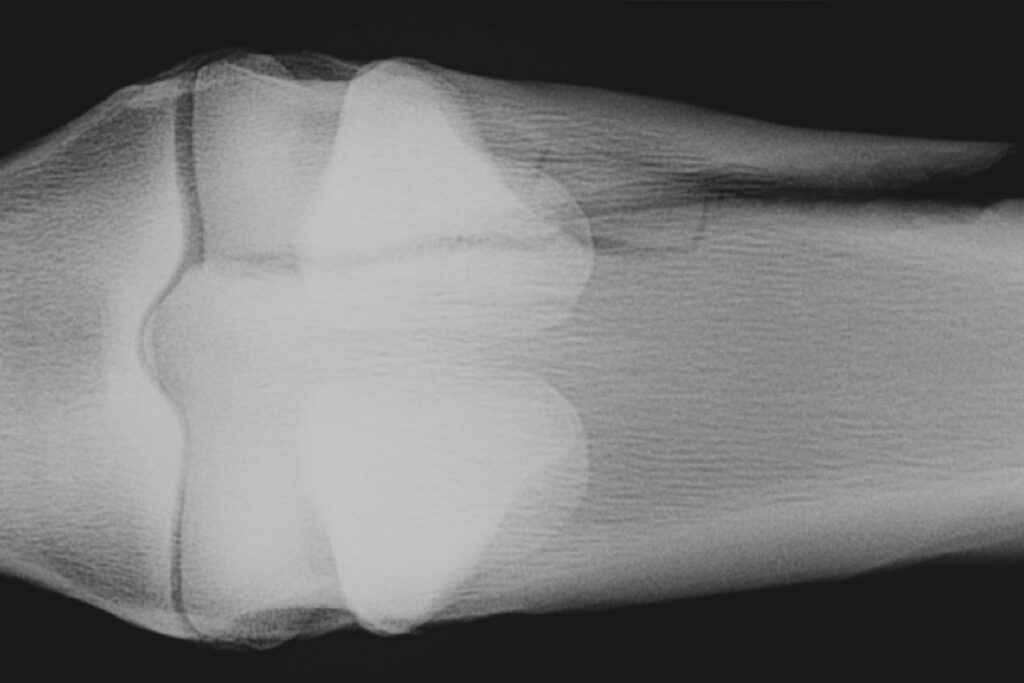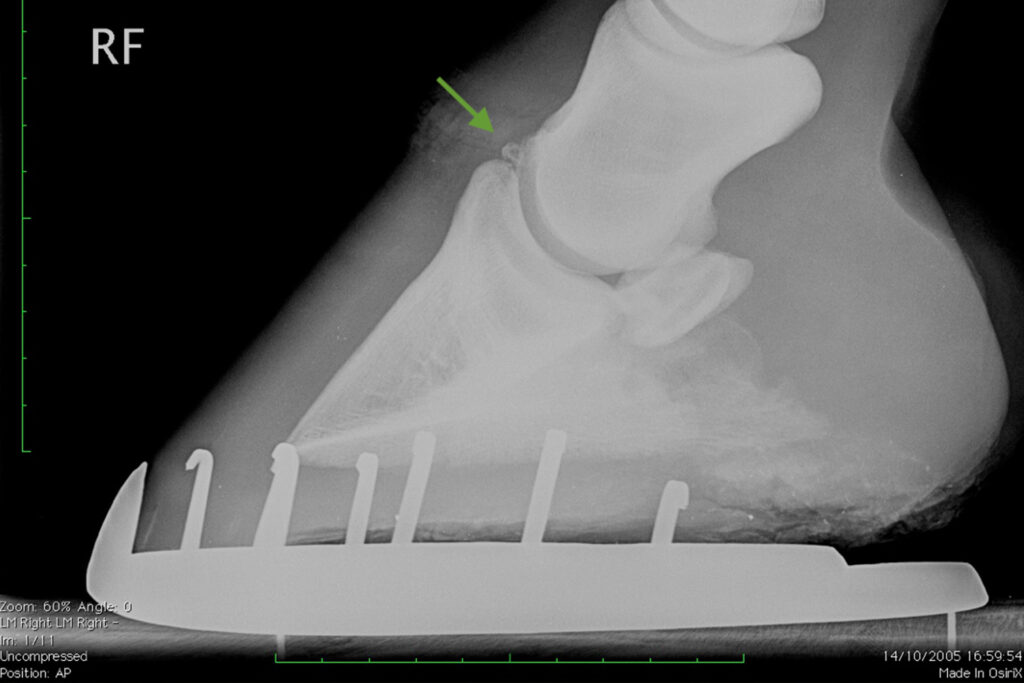Fractures (commonly referred to as ‘broken bones’) can occur due to repetitive concussion and wear over time (so-called ‘stress fractures’) or due to an acute injury. If you suspect that your horse has a fracture, call a vet immediately and try to keep the horse as still as possible until they have been assessed by the vet. If the injury has occurred during turnout then, provided it is safe to do so, place a head collar on the horse and stay with them, holding them where they are and keeping them calm until the vet can assess them before considering moving them.
Fractures can be classified into various categories, including:
- Microfracture – short fracture line; also termed stress fracture
- Hairline – a thin, incomplete fracture; also known as a stress fracture
- Chip – a small piece of bone has separated from the main bone
- Open – the bone has broken out through the skin, also known as a compound fracture
- Closed – the bone has not broken out through the skin
- Transverse – the bone has broken perpendicular to its long length
- Splintered/comminuted – the bone has broken in more than 2 places
- Incomplete – the bone has not broken all the way through from one cortex (side) to another
- Complete – the bone has broken into 2 separate pieces
- Articular – the fracture involves one or more joint surfaces


An incomplete fracture can be converted into a complete fracture if the horse remains unrestricted and is able to move too freely and put too much weight on the broken limb.
The location and type of fracture will dictate the treatment plan and prognosis for the horse’s recovery. The most common locations for fractures are within the lower limb (knee and below or hock and below). Other areas that may be susceptible include the cervical vertebrae (neck) of young horses and the pelvis in horses that complete a lot of fast work as part of their training programme. Fractures of the vertebrae (neck and spine) can put pressure on the spinal cord or nerves meaning that the horse may show neurological symptoms (see below).
Some signs that your horse may have a fracture include:
- Moderate to severe lameness – for some fractures, but not all, the horse will be non-weight bearing
- Heat and/or swelling in the affected area – this may include a joint effusion (excess fluid in a joint)
- Neurological symptoms such as incoordination and/or collapse (Inability to lie down/stand up/roll and/or inability to walk straight)
- Abnormal head, neck, tail or limb position
- Bone visible protruding through the skin
Accurate diagnosis will require a series of X-rays (radiographs) or potentially a bone scan. These may be performed at the yard (simple X-rays) or require a trip to an equine clinic or hospital (complex X-ray studies and bone scans). Your vet will be able to advise you and assist in how best to move and transport a horse with a suspected fracture.
Treatment will vary depending on the severity and location of the fracture. Some fractures may require surgery whilst others may require an extended period of box rest to allow the area to heal. Some may be fatal and/or require euthanasia to prevent further suffering. Your vet will advise you on the best course of action.
Your vet will administer pain relief and, in some cases, antibiotics – for example, if a portion of bone has protruded through the skin or if there are any other wounds that may leave the horse vulnerable to infection.
Rehabilitation from a fracture will be a slow process. A rehabilitation and training plan can be devised by your vet in a step wise fashion based on regular reassessment, and it may be beneficial for you and your vet to work with a veterinary physiotherapist to further support your horse’s recovery.
Preventing Fractures
Some fractures are the result of an accident, and therefore are hard to prevent. However, there are certain things you can do in your daily management to help reduce their occurrence and to help young horses and horses in work to strengthen their bones.
Access to turnout is an essential requirement for horses. Keeping horses in stable field groups allows them to develop an established social order and to get along amicably. This will limit any episodes of kicking behaviour which may cause injury and, potentially, a fracture. Risk will also be reduced if new horses are allowed to first socialise with just one quiet companion in a neighbouring field where they can see the main group over the fence, rather than introducing them directly to an established field group. Keeping mares and geldings in separate field groups is not always essential, but may be necessary for some individuals. For example, some mares will stir up a group when they are in season and are best separated during these weeks, again with a quiet companion. Establishing a routine for the horses will also reduce the risk of injuries, as this helps them to remain settled.
Young horses should be provided with a well-balanced diet to help them grow at an appropriate rate and to develop healthy muscles and bone. They should also be exposed to different ground surfaces and to short but repeated periods of low-grade concussive exercise from a young age to help strengthen their bones in order to withstand ridden work. However, concussive work should not be excessive and, once they are in work, should be done as part of a structured training programme.
Cross-training horses in ridden work on various surfaces (e.g., arena surfaces, roads and grass) promotes strength of the bones and the soft tissues that support them (tendons, ligaments and muscles). All training programmes should be tailored to the individual horse and should consider the horse’s fitness and physical ability, as well as their mental ability to cope with the exercise they are being asked to do.
Throughout all of your horse’s life stages, it is important to feed a balanced diet that is proportional to the workload. A balanced diet should provide all the vitamins and minerals that are necessary to support bone development and remodelling (the natural process whereby bone is deposited in areas of high stress).
Popular advice in Health

Mites: how to treat them in horses
Find out how our experienced teams tackle this itchy problem in affected horses and ponies.
Other advice categories
All webinar categories:
Call our Advice Line
+44 (0)1953 497 238Not found the advice or answer you were looking for here? Then our Advice Line is available during office hours, or you can email us on education@worldhorsewelfare.org to let us know what topics you were looking for.



